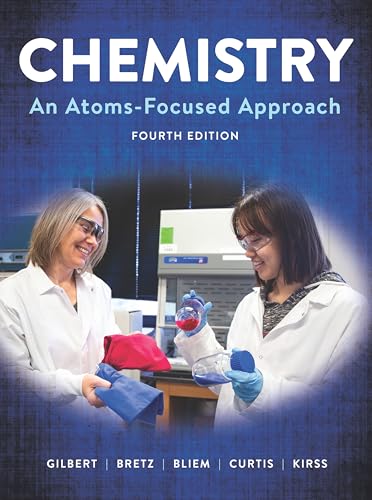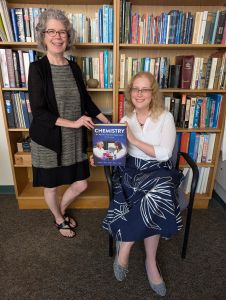Professors Help Flip the Script on Chemistry Education with Atoms-First Textbook

In many ways, the work of Carribeth Bliem and Anna Curtis, both teaching associate professors, on the fourth edition of Chemistry: An Atoms-Focused Approach is a love letter to teaching chemistry—blending curiosity, rigor and inclusivity drawn from more than 30 years of experience and over 15,000 students.
October 4, 2025 | By Dave DeFusco
When Carribeth Bliem first stepped into a lecture hall of first-year chemistry students at the University of North Carolina at Chapel Hill, she didn’t know she would one day help write a textbook that would be used nationwide. What she did know—deeply and instinctively—was that chemistry wasn’t just about equations and reactions. It was about showing students that the discipline touches every corner of their lives.
“I really like teaching first-years,” said Bliem, a teaching associate professor in the Department of Chemistry. “Convincing them that chemistry impacts their daily lives, that’s the heart of it. After years of adapting the pedagogy we use at UNC for large-enrollment classes, the book was just the next logical step. Honestly, it felt like kismet.”
Her co-author, Anna Curtis, also a teaching associate professor, shares that same instinct for asking “why?” and not just in science. Curtis began teaching at UNC in 2019 after earning both her undergraduate degree there and her Ph.D. at the University of Colorado Boulder. Early on, she found herself questioning the traditional sequencing of general chemistry topics.

“I was teaching with a colleague for the first time, running through the traditional order, and she asked me, ‘Why do we teach it this way?’” said Curtis. “If our goal is to help students solve problems in new contexts, not just memorize, we have to start with the fundamentals—the why behind what they’re learning. That’s where the atoms-focused approach comes in.”
Traditionally, general chemistry courses begin with broad concepts like stoichiometry and reactions, only later diving into the atomic and molecular principles that underpin them. The atoms-focused approach flips that order, starting with electrons, nuclei and bonds, then building up to the macroscopic world.
“When you tell students to memorize the charges on common cations in chapter two, but you don’t explain why until chapter seven, it’s frustrating and counterproductive,” said Bliem. “In the atoms-focused order, we teach the why first.”
Bliem and Curtis were thrilled when the department adopted the previous edition of the textbook in Spring 2022, though they never imagined becoming part of the author team. That summer, while developing course materials for the new edition, they met Norton’s editor at a chemistry education conference and offered suggestions for enhancing Chemistry: An Atoms-Focused Approach, 3rd Edition, drawing on their expertise as both physical chemists and educators.
For example, one theme Bliem and Curtis emphasize throughout their courses is the central role of energy in shaping chemical intuition about atoms. When the editor invited them to audition as co-authors, they demonstrated how introducing energy concepts earlier could strengthen and expand the book’s opening chapters.
“Even if nothing came of the audition process, I’d at least shared ideas I think are essential for student growth,” said Bliem. “But it all fell into place.
Both professors are known for their highly structured, active-learning style—a method that engages students in problem-solving rather than passive note-taking. Translating that into a textbook meant making it more than a static reference. The fourth edition of Chemistry: An Atoms-Focused Approach introduces two signature features:
- Stepwise Figures, formulated by Bliem, break complex visuals into smaller, ordered steps, modeling for students how to demystify visuals by asking guiding questions at each stage.
- ChemTours, developed by Curtis, use sequential questions paired with interactive visuals and animations to guide students toward a deeper understanding of course concepts.
“These features are designed to simulate the active learning we do in the classroom,” said Curtis. “Students don’t just get the answer, they engage with the reasoning process.”
Stepwise Figures and ChemTours: Guided Inquiry are found within Norton’s learning system, which includes Smartwork online homework and an interactive e-text. In Smartwork, instructors can search a vast question bank by topic, learning objective or Bloom’s taxonomy level or use pre-made assignments, adaptive modules and math-prep sets to meet students where they are. The result is a fully integrated learning system—textbook, modules, activities and assessments all aligned in art and vocabulary.
“That consistency is vital for novice learners,” said Curtis. “As chemists, we can say the same thing five different ways and know we mean the same thing. But to a student, that’s five different concepts. Consistency removes that barrier.”
When students can recognize themselves and their career aspirations in course materials, they are more motivated to learn. To support this, the text highlights scientists from diverse backgrounds and showcases a wide range of career paths. The cover of the fourth edition features Professor Sonja Salmon and a member of her research team, Siyan Wang, who developed a textile recycling method at North Carolina State University. Real-world contexts, from textile chemistry to environmental science, help students connect classroom learning to their daily lives and future professions.
In many ways, Bliem and Curtis’s work on the new textbook is a love letter to teaching chemistry—blending curiosity, rigor and inclusivity drawn from more than 30 years of experience and over 15,000 students. They credit their co-authors, Tom Gilbert and Stacey Lowery Bretz, whose expertise and collaboration were essential in bringing their shared vision for the edition to life.
“We want to give students the tools to think critically, solve problems and connect chemistry to their daily lives,” said Bliem, “and we want them to believe they can do it.”
Curtis agrees. “With a growth mindset and the right learning environment, all students are capable of learning chemistry. That’s the foundation of everything we do.”

